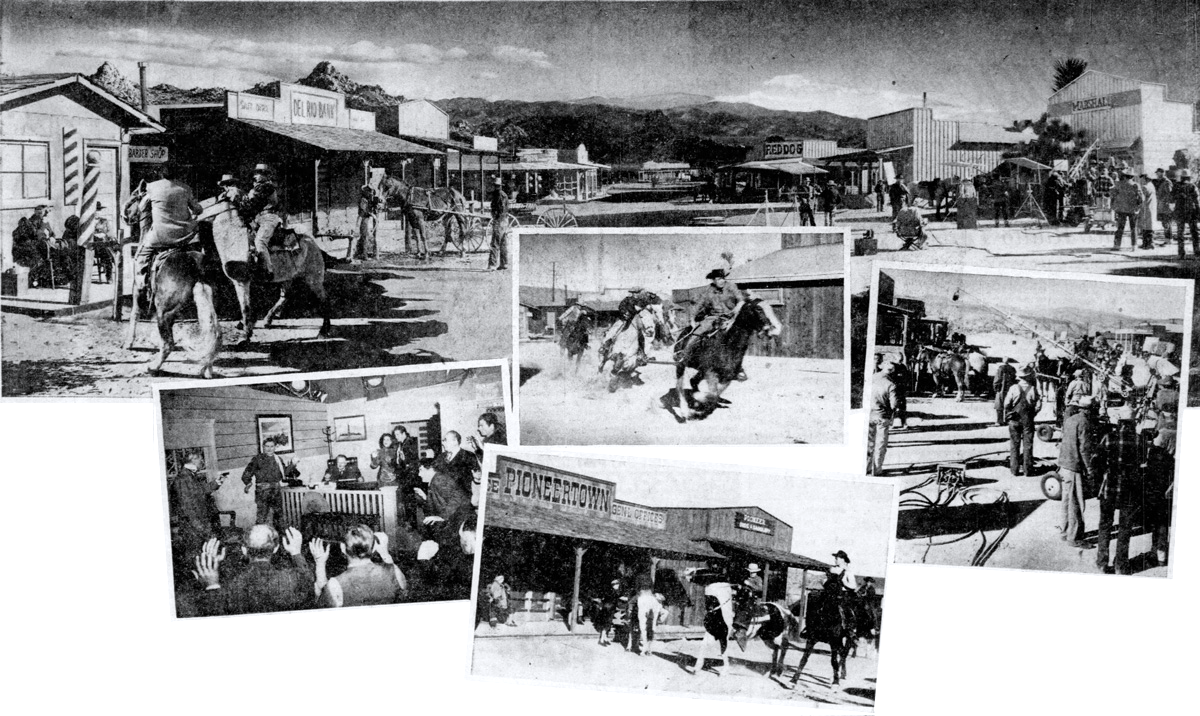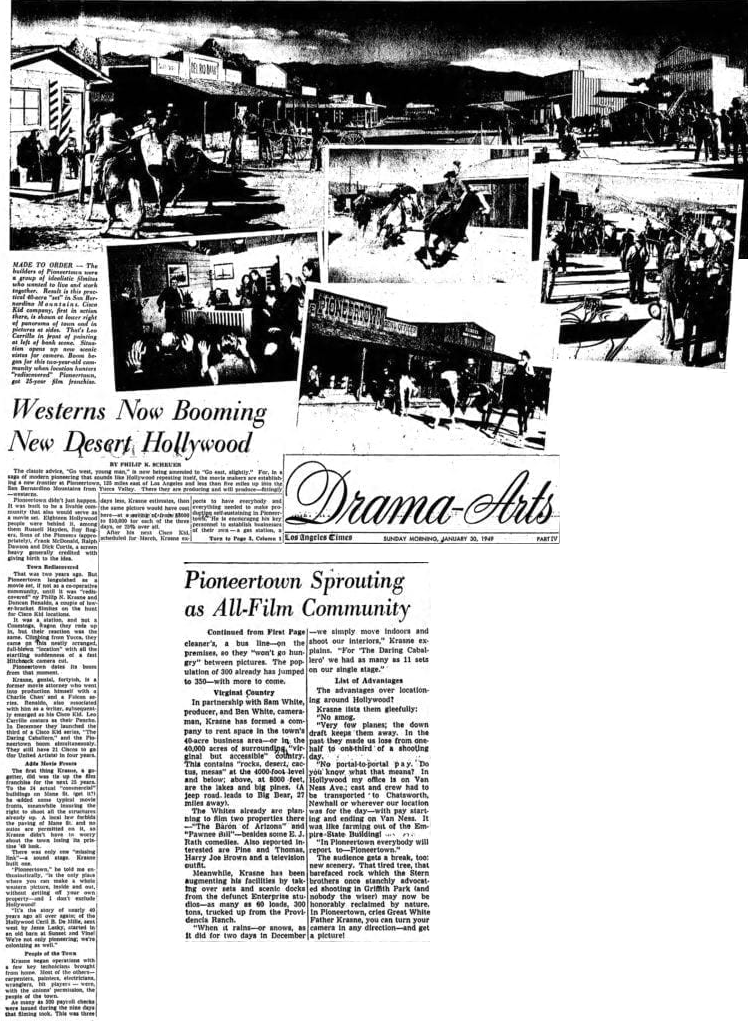Westerns Now Booming New Desert Hollywood

BY PHILIP K. SCHEUER
The classic advice, “Go west, young man,” is now being amended to “Go east, slightly.” For, in a saga of modern pioneering that sounds like Hollywood repeating itself, the movie makers are establishing a new frontier at Pioneertown, 125 miles east of Los Angeles and less than five miles up into the San Bernadino Mountains from Yucca Valley. There they are producing and will produce—fittingly—westerns.
Pioneertown didn’t just happen. It was built to be a livable community that also would serve as a movie set. Eighteen Hollywood people were behind it, among them Russell Hayden, Roy Rodgers, Sons of the Pioneers (appropriately Frank Mc Donald, Ralph Dawson, and Dick Curtis, a screen heavy generally credited with giving birth to the idea.
That was two years ago. But Pioneertown languished as a movie set, if not as a co-operative community, until it was “rediscovered” by Philip N. Krasne and Duncan Renaldo, a couple of lower-bracket flimites on the hunt for Cisco Kid Locations.
Town Rediscovered
It was a station and not a Conestoga wagon they rode up in, but their reaction was the same. Climbing from Yucca, they came on this neatly arranged, full-blown “location” with all the startling suddenness of a fast Hitchcock camera cut.
Pioneertown dates its boom from that moment.
Krasne, genial, fortyish, is a former movie attorney who went into production himself with a Charlie Chan” and Falcon series. Renaldo, also associated with him as a writer, subsequently emerged as his Cisco Kid. Leo Carrillo costars as their Pancho. In December they launched the third of a Cisco Kid series, “The Daring Caballero,” and the Pioneertown boom simultaneously. They still have 21 Cisco’s to go (for United Artists) in four years.
Adds Movie Fronts
The first thing Krasne, a go-getter, did was tie up the film franchise for the next 25 years. To the 24 actual “commercial” buildings on Mane St. (get it) he added some typical movie fronts, meanwhile ensuring the right to shoot all the structures already up. A local law forbids the paving of Mane St. and no autos are permitted on it, so Krasne didn’t have to worry about the town losing it’s ’49 look.
“Pioneertown,” he told me enthusiastically, “is the only place where you can make a whole western picture, inside and out, without getting off your own property—and I don’t exclude Hollywood!
“It’s the story of nearly 40 years ago all over again; of the Hollywood Cecil B. De Mille, sent west Jesse Lasky, started in an old barn at Sunset and Vine! We’re not only pioneering; we’re colonizing as well.”
People of the Town
Krasne began operations with a few key technicians brought from home. Most of the others—carpenters, painters, electricians, wranglers, bit players – were, with the unions’ permission, the people of the town.
As many as 300 payroll checks were issued during the nine days that filming took. This was three days less, Krasne estimates, than the same picture would have cost here—at a cost of $5000 to $10,000 for each of the three days, or 25% over all.
After his next Cisco Kid scheduled for March, Krasne expects to have everybody and everything needed to make production self-sustaining in Pioneertown. He is encouraging his key personnel to establish businesses of their own –a gas station, a
Turn to Page 3
Continued from First Page
Pioneertown Sprouting As All-Film Community
Cleaner’s, a bus line—on the premises, so they “won’t go hungry” between pictures. The population of 300 already has jumped to 350—with more to come.
Virginal Country
In partnership with Sam White, producer, and Ben White, cameraman, Krasne has formed a company to rent space in the town’s 40-acre business area—or in the 40,000 acres of surrounding “virginial but accessible” country. This contains “rocks, desert, cactus, mesas” at the 4000-foot-level and below; above, at 8000 feet are the lakes and big pines. (A jeep road leads to Big Bear, 27 miles away).
The Whites already are planning to film two properties there—“The Baron of Arizona” and “Pawnee Bill”—besides some E.J. Rath comedies. Also reported interested are Pine and Thomas, Harry Joe Brown and a television outfit.
Meanwhile, Krasne has been augmenting his facilities by taking over the sets and scenic docks from the defunct Enterprise studios—as many as 60 loads, 300 tons, trucked up from the Providencia Ranch.
“When it rains—or snows, as it did two days in December—we simply move indoors and shoot our interiors,” Krasne explains, “For Daring Caballero’ we had as many as 11 sets on our single stage.”
List of Advantages
The advantages over locationing around Hollywood?
Krasne lists them gleefully:
“No smog.
“Very few planes; the down draft keeps them away. In the past they made us lose on- half to one-third of a shooting day.
“No portal-to-portal pay. Do you know what that means? In Hollywood my office is on Van Ness Ave; cast and crew had to be transported to Chatsworth, Newhall or wherever our location was for the day—with pay starting and ending on Van Ness. It was like farming out of the Empire State Building!
“In Pioneertown everybody will report to—Pioneertown.”
The audience gets a break, too: new scenery. That tired tree, that barefaced rock with the Stern brothers once staunchly advocated shooting in Griffith Park (and nobody the wiser) may now be honorably reclaimed by nature. In Pioneertown, cries Great White Father Krasne, you can turn your camera in any direction—and get a picture!

